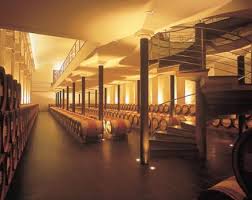Chateau
Croizet-Bages, as its name implies, is located on the Bages plateau. Located
between Pauillac and St-Julien, the estate is named after the family who owned
the land in the 16th century. There are numerous chateaux on that
plateau, including Lynch-Bages, Haut-Bages-Liberal, Cordeillan-Bages and Haut-Bages-Averous.
It was
only until the 18th century that the property came into ownership of
the Croziet brothers, who were local officials. They sold the property later,
around the time of the Revolution, to a Gascon named Jean de Puyterac, who
maintained ownership until shortly before the 1855 classification.
At that
time it came into the hands of Julien Calve, who also renamed the estate
Croizet-Calve. It was classified a fifth growth in the 1855 classification, and
by WWI it was sold to Jean-Baptiste Monnot, an American citizen, who continued
running the estate until 1942.
It was then
acquired by Paul Quie, who was a wine merchant. By 1968 he passed to his son
Jean-Michel, turning over yet again in 2001 by the next generation of Jean-Philippe
and Anne-Francoise.
 The
vineyards are located in the heart of the Bages plateau, with typical Medoc
gravel soil, but only of a metre deep over a bed of sand. The total size is
about 30 ha, planted with 60% Cabernet Sauvignon, 32% Merlot, and 8% Cabernet
Franc, with average vine age of 35 years. The planting density is 8000 vines
per ha, with a yield of 55 hl / ha.
The
vineyards are located in the heart of the Bages plateau, with typical Medoc
gravel soil, but only of a metre deep over a bed of sand. The total size is
about 30 ha, planted with 60% Cabernet Sauvignon, 32% Merlot, and 8% Cabernet
Franc, with average vine age of 35 years. The planting density is 8000 vines
per ha, with a yield of 55 hl / ha.
The
quality of the wine improved in recent years due to the increased attention in
the vineyards, with re-trellised vines, to increase height of the vine and
foliage surface. Winter pruning and spring debudding has also been carried out,
with leaf-thinning and green harvesting to control yield.
 One of
the exceptions in Medoc, machine harvesting is adopted in the property. There
is no chateau on the property, with the harvest going into cement vats with 10%
bled off to increase extraction. Cold maceration of up to 48 hours is adopted,
followed by temperature controlled fermentation.
One of
the exceptions in Medoc, machine harvesting is adopted in the property. There
is no chateau on the property, with the harvest going into cement vats with 10%
bled off to increase extraction. Cold maceration of up to 48 hours is adopted,
followed by temperature controlled fermentation.
After
malolactic fermentation, the press wine and various other lots are kept separate,
going into oak barrels of which 25% are new, for up to 12 months. The wine is
regularly racked, fined with egg white and then bottled. The grand vin is
Chateau Croizet-Bages, with a second wine La Tourelle de Croziet-Bages.
I have
recently tasted the 2004 vintage and below is my tasting note:
Appearance
Bright and clear, this wine is of medium ruby color, with legs.
Bright and clear, this wine is of medium ruby color, with legs.
Nose
Clean, the nose shows medium (+) intensity aromas of black fruit such as blackcurrant and black cherry, maturity notes of tobacco and bits of savory, pungent spice of liquorice, MLF notes of cream, oak notes of cedar, mineral notes of pencil lead, and kernel notes of coffee. The wine is developing.
Palate
Dry, it has medium acidity and medium (+) tannin of ripe and velvety texture. The alcohol level is medium, with a medium (+) body, showing medium intensity flavors of black fruit such as black cherry and dark plum, animal notes of raw meat, herbaceous notes of blackcurrant leaf, oak notes of cedar, kernel notes of chocolate. The wine has a medium finish.
Conclusion
Good quality Pauillac with a fairly intense nose of good complexity, though the wine needs to air for about 2 hours before enjoying and got a weird aromas initially. The palate is a bit too herbaceous, and probably due to the issue of the ripeness, with a reasonable concentration and complexity. Overall a wine of balance and structure, it has a fair length and is ready to drink now, though can benefit from further ageing of another 2-3 years.























